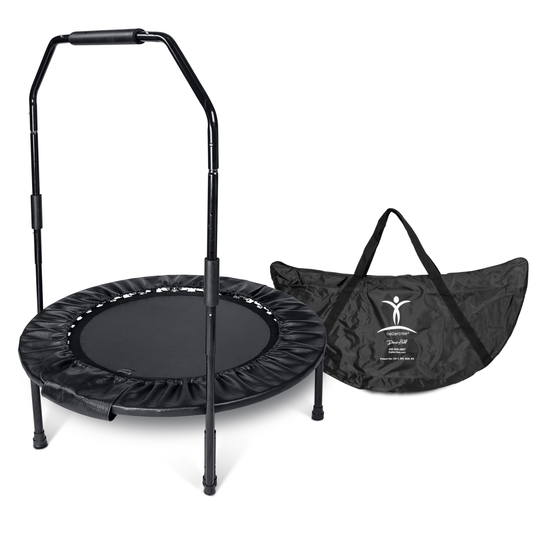Disclaimer: This Blog/Web Site is made available by the publisher for educational purposes only as well as to give general information & understanding regarding the industry. It is not to be used as specific medical advice or to replace consulting with your doctor. You should always consult with your doctor. By using this Blog / Web Site you understand that this Blog/Web Site should not be used as a substitute for medical advice from a licensed professional. For our full disclaimer, please read: Cellercise® Disclaimer
Rebounders are becoming widely recognized as a great way to build your strength and stay fit. People are beginning to ditch the gym and work out on their rebounders at home. However, jumping up and down in random spurts is not the only way to get exercise on your rebounder. Many specific exercises and strategies allow you to take full advantage of your rebounder.
Tips for Before You Begin
Before you start working out on your rebounder, it is important to keep some things in mind. Arguably the most important is to remember to keep breathing while you are working out on your rebounder. Do not hold your breath. Make sure you are challenging yourself, but do not go overboard. Like any workout, if you push yourself too hard you could suffer an injury or strain a muscle. Slowly increase the difficulty of your workouts as you continue, but take your time. Another important thing you should do to prevent injuries is stretch. Make sure you stretch before and after your rebounder workouts, especially if they were intense. One of the keys to using a rebounder is having steady balance. If you are worried about your balance, you can order a front or side bar to support you until you feel more confident about your balancing abilities. Though rebounder workouts seem more casual than going to the gym, you should still have the proper gear. Wear comfortable clothing so that your body can move freely.
The Health Bounce Exercise
The health bounce is the easiest exercise to do on your rebounder, so it can be a great place to start. Stand on the mat with your feet shoulder-width apart and bounce lightly up and down without your feet leaving the mat. Doing this simple bounce a few times a day will help flush your lymphatic system and energize your immune system. Use this as a warm-up to a more intense rebounder workout, or as a casual activity to do randomly a few times throughout the day. For the health bounce you can wear shoes or go barefoot, but wearing only socks can be dangerous because it becomes slippery and you may fall.
The Aerobic Bounce
Rebounders are great for aerobics because they absorb 87% of the shock of the bounce, making it easier on your back, knees, and feet. They actually encourage healing in those areas. NASA claims that aerobics on a rebounder are 68% more effective than running and jogging and uses rebounders to help injured astronauts recover from weakened conditions. The aerobic bounce can be anything that you want. Some people run, jog, or sprint in place. Others do jumping jacks. Anything that gets your heart rate going is an effective version of the aerobic bounce. One of the great things about aerobic rebounder workouts is that they are easy and convenient to do. You can watch your favorite television show while doing aerobics on a rebounder. Some people use commercial breaks as an opportunity to do an aerobic bounce on their rebounder.
The Strength Bounce
The strength bounce is more difficult than the health or aerobic bounce exercises. Before beginning, make sure you feel balanced and centered and position the rebounder away from any sharp edges or corners in the room. The strength bounce involves continuously jumping as high as you can. Though this exercise sounds easy, it can become extremely tiring after just a couple minutes. It will strengthen your cells and work the muscles in your legs and core. You should do the strength bounce in small intervals, as opposed to a single session for a long period. Do it for a few minutes and then take a break before doing it again and continue in the same fashion.
The Sitting Bounce
The sitting bounce best suits people who are in a weaker condition and have a hard time standing on the mat for an extended time. For the sitting bounce, the person sits on the mat while another person bounces lightly behind them. Another method involves bouncing lightly on one’s own, still in a sitting position. This bounce will flush the lymphatic system and boost the immune system. The sitting bounce is the first step in a weakened person regaining strength. After they grow stronger, they can try doing the same light bounce while standing and holding onto something. Once they feel healthy enough, they can try bouncing standing up without any support. People also use the sitting bounce to strengthen their core. Sit on the mat, lean back slightly, and take your feet off of the floor. Try and bounce, while using your core to stabilize your body. The stronger you get, the more you can stretch your legs out in front of you. This bounce strengthens your abs, back, and legs.
NOTE: Remember to always consult with your doctor or health professional before starting new exercise routines.
Get Your Cellerciser® and start rebounding today!














